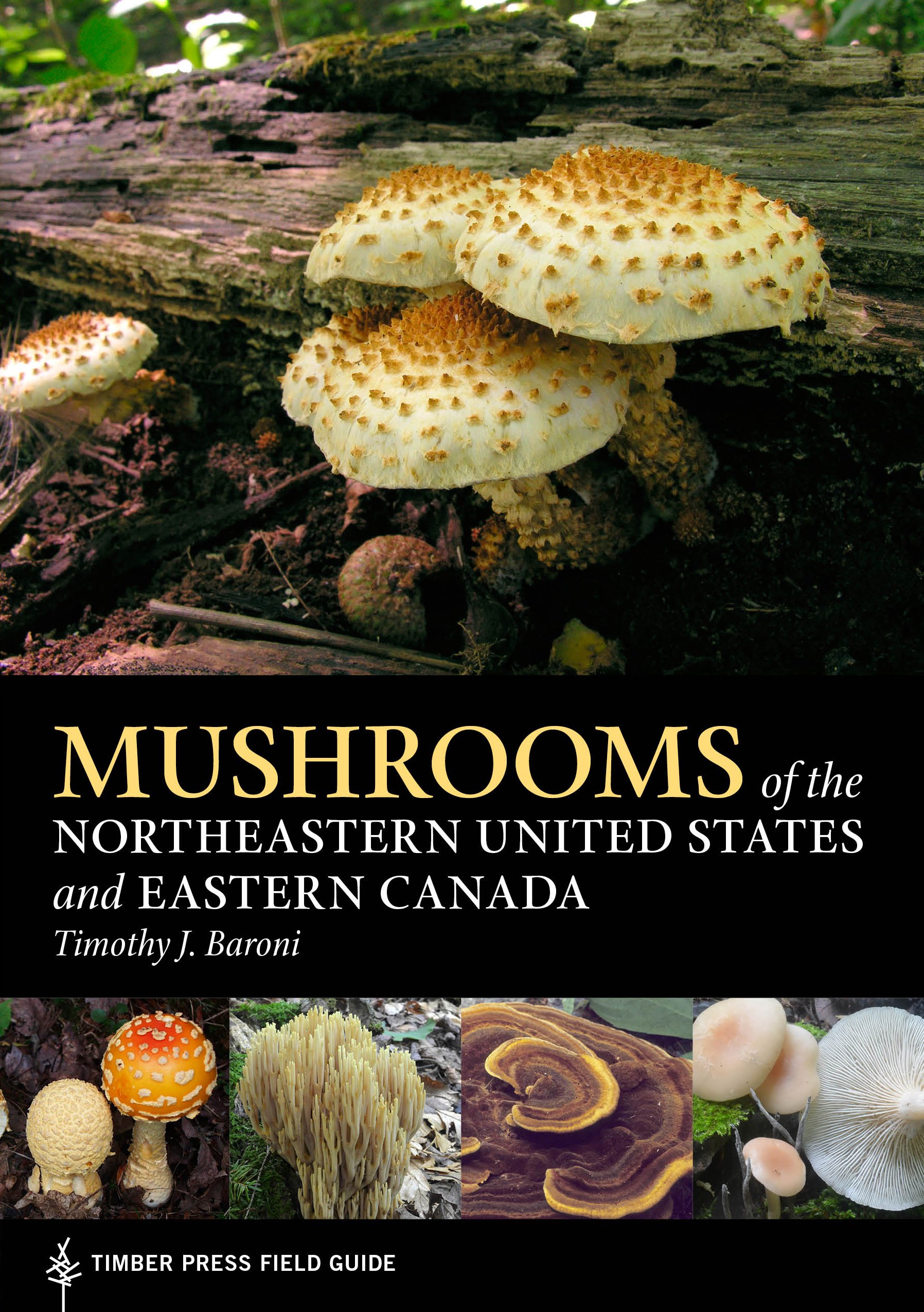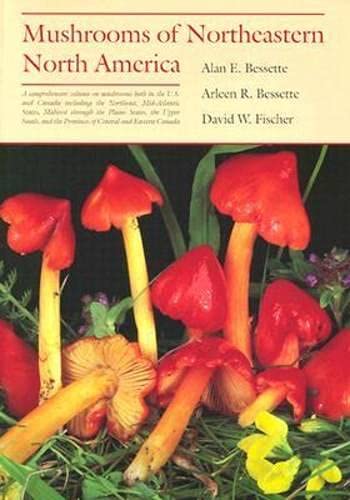Massachusetts is a small state that feels big. Maybe it’s because most of the other states in the Northeast are also small or smallish, or maybe it’s because Massachusetts stretches from the beaches and islands of the coast all the way back into the Berkshires, a range of high, long hills within the ancient Appalachian chain. Either way, it has more mushrooms than we can fit in one article[i], so here is just a brief sampling of what the state has to offer[ii].
Edible Wild Mushrooms in Massachusetts
Identifying edible wild mushrooms is not usually as hard as it’s made out to be—the problem is the word “usually.” There are a few species that have close and very dangerous look-alikes, plus species that are safe to eat sometimes but dangerous at other times and no one knows why, and in many cases what was once thought to be one species is actually a whole group, and no one is really sure yet that the entire group is safe to eat. It takes real expertise to know for sure that a mushroom isn’t one of these confusing species! Plus, the more a person knows about mushrooms, the easier it is to notice the details on which identification depends.
So nobody should feel intimidated about getting to know mushrooms. Learning the basics doesn’t take long, and a beginner can start identifying at least some mushrooms almost immediately. The only real problem is that beginners don’t yet know enough to realize what they don’t know, and for that reason it’s always best to get an expert to identify anything destined for the table.
This list is introductory and not a replacement for a field guide, spore prints, or an identification app. If you go mushroom hunting local experts are your best bet for safety. Oh, and make sure you take a quality knife with you and a basket/bag for your finds!
Our Recommended Field Guides in Massachusetts
COVER | TITLE | Header | ||
|---|---|---|---|---|
OUR #1 RATED | ||||
Lobster Mushrooms
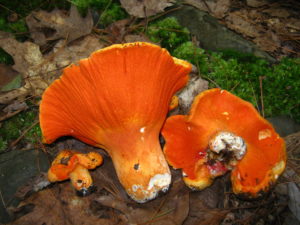
Lobster Mushroom[iii] is not exactly a species—more like a symptom. The fungus, Hypomyces lactifluorum, which does not itself produce mushrooms (not all fungi do) is a parasite, growing on and feeding from mushrooms of the Russula and Lactarius genera. The mycelium of the host mushroom is unharmed and can produce new mushrooms, but the mushroom with the parasite on it can’t set spores. The parasite releases its own spores instead. The parasite also alters the color, texture, shape, and even taste of the host mushroom, to the point that the species of the host can’t be easily identified. The parasite and its altered host together become the lobster mushroom. Regardless of the host species, lobster mushrooms are easily recognizable as lobsters and have a subtle, seafood-like flavor that is intensified by drying or proper cooking[iv].
There doesn’t seem to be any reason why H. lactiforum couldn’t attack one of the poisonous Russulas, but there’s no record of anyone getting poisoned by eating a lobster mushroom in good condition. Either the parasite avoids the poisonous species after all, or it detoxifies them. Some people do have allergic reactions, though, and old or spoiled specimens can make people sick.
Witch’s Butter (Tremella mesenterica)
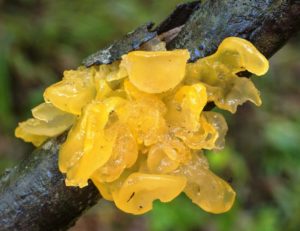
Witches’ butter is too odd to ignore, though it is too small and too nearly tasteless to be a popular edible. Its fruiting body is a little globby of yellow or (rarely) white, more like jelly than butter. It is parasitic on the mycelia of wood-decomposing fungi delightfully weird not to mention. The fruiting body takes the form of little yellow blobbies (there is a rare white form, too), looking less like butter and more like jelly. Though tasteless in a strict sense, it reportedly makes the tongue tingle, rather like a menthol cough drop might[v].
Actually, T. messenterica is only one of three yellow witch’s butter species, but the same description applies pretty well to all three.
Chanterelles and Trumpets
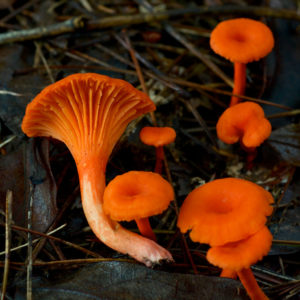
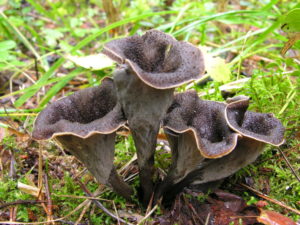
The Chanterelles are a group of trumpet-shaped mushrooms with ridges rather than gills that vary from good to extremely delicious. Cantharellus is usually referred to as the Chantarelle genus, and most chants are members, but there are exceptions—the Craterellus genus particularly is very similar, and while its members are usually called trumpets, some are often referred to as chanterelles.
Massachusetts has at least one true chant, the Red Chanterelle (Cantharellus cinnabarinus), plus the Black Trumpet (Craterellus fallax), which is sometimes called the Black Chanterelle—and is sometimes listed as C. cornucopioides, actually a European species[vi].
Honey Mushrooms (Armillaria sp.)
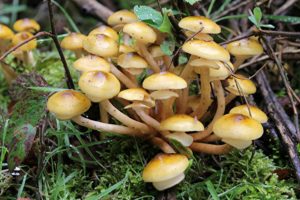
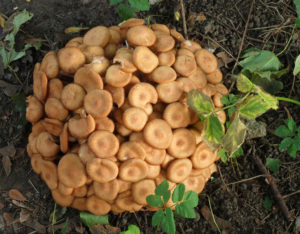
Honey mushrooms are named for their color—they are not especially sweet, though they are traditionally considered edible. Some people do react badly to them, and as it’s not yet known why, some experts recommend not eating honeys at all. Others go right on eating them without trouble)[vii] They do have a deadly look-alike, though, so extreme caution with identification is important.
Honeys attack living trees, eventually killing them. Technically, that makes them predators rather than parasites, though it does sound odd to refer to an herbivore as a predator. Although the mushrooms themselves are medium-sized to small (they count as LBMs, or “little brown mushrooms”), the fungal organisms as a whole can be very large. The mycelium produces thick, black, root-like structures to reach underground from one tree to the next—in fact, the largest known organism in the world is a honey mushroom fungus in Oregon[viii] that covers several square miles of forest, gradually eating thousands of trees more or less at once.
There are many honey mushroom species. Massachusetts has at least two, A. mellea and A. tabescens. The latter is distinctive in not having a ring.
Enokitake (Flammulina velutipes)
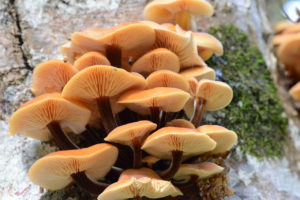
The Velvet Foot has a dual identity, but it’s not the mushroom’s fault. Growing wild, it is a fairly typical LBM that decomposes dead wood. It’s a well-known edible, although it shares its habitat with a deadly-poisonous look-alike, making proper identification critical. However, it is also cultivated, and the traditional method involves restricting both light and oxygen, which forces the mushrooms to become thin and white with very tiny caps. The cultivated form is known by its Japanese name, Enokitake, or sometimes just “enoki,” for short.
Bear’s Head Tooth (Hericium americanum)
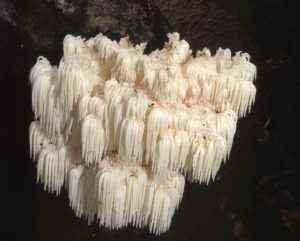
The awkward common name gets a bit easier when one considers that “Bear’s Head” is a compound adjective. That is, this is a tooth mushroom (it has long, hairlike teeth rather than gills), that somebody has compared to a bear’s head. It is not a “head-tooth” mushroom belonging to a bear.
But the resemblance to a bear’s head is less than slight. This is one of several species where the fruiting body consists of several branches all entirely covered in what looks like fleshy, white or yellowish hair. It’s also edible, and tastes a lot like crab.
Many writers treat all Hericiums as interchangeable, referring to them all as “Lion’s Mane” and stating that they all have identical health properties. There is no evidence for that. Reportedly, they do taste alike, though.
Magic Mushrooms in Massachusetts
The use or possession of Psilocybin (inside of a mushroom or otherwise) is illegal under United States law and under Massachusetts state law—but under state law it’s not very illegal. Maximum jail terms are relatively short, plus several cities have decriminalized psilocybin[ix]. The state is relatively psilocybin-friendly, though legal issues are still important concerns for users.
Another important concern is the presence of toxic look-alikes, some of them deadly. It’s important to positively identify every wild mushroom before eating. “Hey, this looks like those shrooms my friend grows!” is simply not good enough.
That being said, Massachusetts is home to a number of psychoactive mushroom species. They are worth knowing about.
Gymnopilus
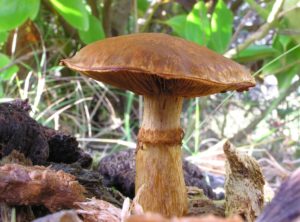
Only a few species in the Gymnopilus[x] genus are “active,” and they are rarely used, their effects are not well-known. The taxonomy is not entirely clear, either. Massachusetts has one or more species in the confusing G. junonius group[xi].
Banded Mottlegill (Panaeolus cinctulus)
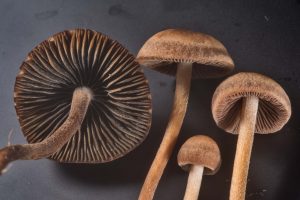
Named for the contrasting band of color around the rim of the cap, Banded Mottlegill (P. cinctulus),[xii] is one of several psilocybin-containing members of its genus, a group commonly called the Mottlegills because their spores mature and darken unevenly. Some psychoactive Mottlegills are very potent, but this one is not—it’s better suited for microdosing, perhaps.
Psilocybe
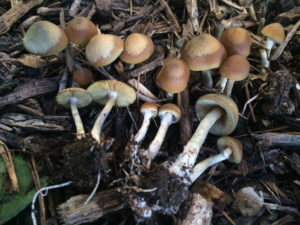
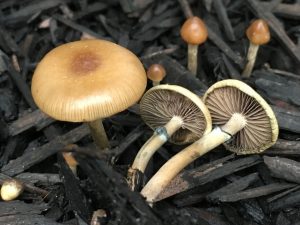
Psilocybe is the most famous genus of “magic” mushroom, perhaps because P. cubensis is among the most widely cultivated psychoactive mushrooms in the world. It is doubtless cultivated in Massachusetts, but doesn’t grow wild there. One species that does, P. ovoideocystidiata[xiii], is the larger of two species commonly called “Blue-Foot.” Stuntz’s Blue-Legs (Psilocybe stuntzii)[xiv], is considered only weakly psychoactive. Some collectors claim to have found it in Massachusetts, though other authorities list it as exclusive to the Pacific Northwest.
Fly Agaric (Amanita muscaria)
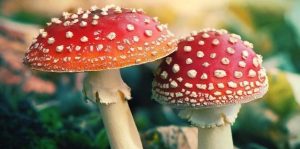
Fly agaric has a very long history of use for its psychoactive properties, but it’s also dangerously poisonous if not processed properly. It does not contain psilocybin, and is biochemically very different from those mushrooms that do. Some people find its use spiritually helpful, but the danger is that psychonauts may discount tales of its poisonous nature as mere propaganda and not take the risk seriously. The truth is that although fatalities are rare, they do occur, and improperly-processed mushroom leads to an extremely unpleasant trip. Plus, there is the danger of mistaking this species for one of its even more dangerous relatives.
Poisonous Mushrooms in Massachusetts
Don’t assume that a mushroom not on this list is edible. There are too many poisonous mushrooms to list here, and there are many species of unknown status. It’s also worth reiterating that a lot of species arguably fit on both the edible and non-edible lists, since they sicken some people but not others, or because they can be processed in such a way as to remove their toxins. In many cases, the status of a species is the subject of fierce debate. It’s important to become aware of those debates and the reasons for them.
Destroying Angel (Amanita sp.)
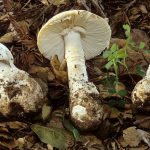
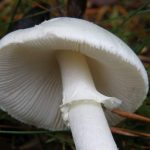
The name, Destroying Angel, refers to several very similar, all-white or whitish species, a small subset of the Amanita genus (Amanita bisporigera, Amanita ocreata or Amanita virosa). It’s difficult to be sure which of these species Massachusetts has, but they all contain lethal concentrations of the same toxin. This toxin shows no symptoms at all for as mush as a day. Then, after several days of intense gastrointestinal upset, the patient seems to entirely recover, just before the liver and kidneys fail. Very few people survive, even with intensive medical care. Some do. It’s not hopeless.
Obviously, Destroying Angel isn’t on anybody’s grocery list, but it’s often eaten by mistake by people who forget to check details like spore print color. In its early “egg” form, it also resembles some puffball species, until sliced open. This is one of several dangerously toxic Amanita species—though there are also some safely edible Amanitas, most experts recommend giving the entire genus a hard pass rather than risking mistaking one for another.
Jack O’Lantern (Omphalotus illudens)
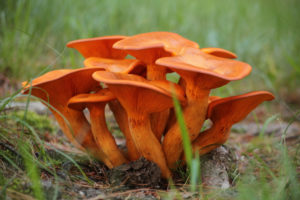
Jack o’Lantern Mushroom[xv] very faintly resembles some Chanterelle species (which may or may not grow in Massachusetts) and is sometimes eaten by hopeful mycophiles who fail to notice that it has gills—real chants don’t. It is those very gills that interest other enthusiasts, as they are said to glow in the dark. The glow must very very faint, though, as plenty of people have failed to see it after years of trying. Those who eat the mushroom are even more sorely disappointed—they get very, very sick. There are multiple Jack o’Lantern species. This is the one in Massachusetts.
Scaly Chanterelle (Turbinellus floccosus)
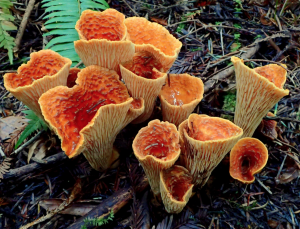
The possibly-toxic Scaly Chanterelle[xvi], on the other hand, looks very much like a Chanterelle, hence the name. Some people eat it without difficulty, while others eat it and get sick. As usual with mushrooms, it’s not clear yet what makes the difference.
The Sickener (Russula sp.)
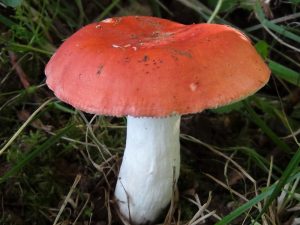
Any red-capped Russula can be fairly called “sickener,” since most will make an eater sick[xvii], and identifying Russulas down to species-level is reportedly a job for extremely well-educated masochists[xviii]. Some writers still list all or most of these pretty red-and-white mushrooms as Russula emetica, but that is a relic of a simpler time, before microscopes and DNA studies were brought to bear on mycology.
Earthball (Scleroderma citrinum)
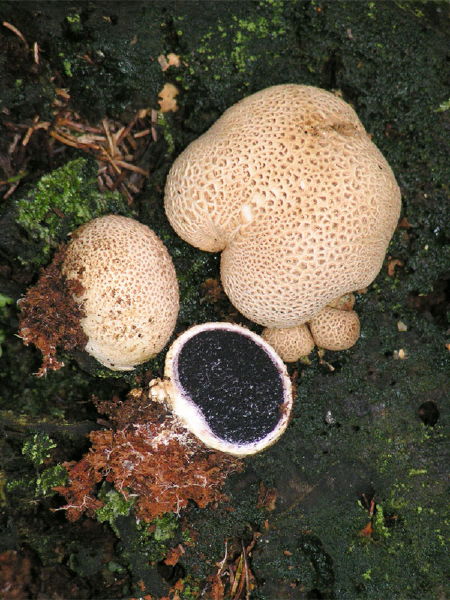
“Everybody knows” that all Puffballs are safe to eat, at least until the spores begin to mature. And the old adage is true, inasmuch as ball-shaped mushrooms that puff and are toxic aren’t called Puffballs. This one is called the Earthball[xix]. It’s not deadly, but does make an eater very, very sick. Its thick skin, it’s firmness (more like a ball than a marshmallow), and its interior that starts turning dark very young, all warn the observant forager that this is not food.
Deadly Galerina (Galerina marginata)

The Deadly Galerinal[xx] is the reason to be extra-careful with identification for all LBMs, including honey mushrooms, velvet foot, and the vast majority of “magic” mushrooms. It is small, brown, nondescript, and capable of killing most people who eat it. Its toxin is the same as that of a destroying angel. Even more frightening, it shares a habitat with, and can grow inside clumps of, some of its look-alikes.

My name is Austin Collins.
I've dedicated my life to Mushrooms.
I believe Mushrooms are the best kept secret when it comes to health and well being.
For that reason, I would like to share a company with you that in my opinion makes the best mushroom products on the market.
The company is called Noomadic Herbals, my favorite supplement they make is called "Mushroom Total".
I take their products every day and they have helped me think better and have more energy. Give them a try.
-Austin
References:
[i] (n.d.). Massachusetts Mushrooms. A. Sergeev
[ii] (n.d.). Massachusetts Mushrooms. iNaturalist
[iii] Volk, T. (2001). Tom Volk’s Fungus of the Month for August 2001. Tom’s Fungi
[iv] Bergo, A. (n.d.). Lobster Mushrooms. Forager Chef
[v] Adamant, A. (2018). Foraging Witch’s Butter Mushroom. Practical Self-Reliance
[vi] Kuo, M. (2015). Craterellus fallax. MushroomExpert
[vii] (n.d.). Armillaria solidipes Peck. California Fungi
[viii] Patton, V. (2015). Oregon Humongous Fungus Sets Record as Largest Single Living Organism on Earth. Oregon Public Broadcasting
[ix] (2021). Psychedelic Laws in Massachusetts. Psychedelic Invest
[x] (n.d.). Gymnopilus. Wikipedia
[xi] Kuo, M. (2012). Gymnopilus luteus. MushroomExpert
[xii] (n.d.). Panaeolus cunctulus. Philosophy
[xiii] Roderick (2019). Psilocybe ovoideocystidiata. Psillow
[xiv] (n.d.). Psilocybe stuntzii. Burke Harbarium Image Collection
[xv] (n.d.). Omphalotus illudens (Schwein.) Bresinky & Besl—Jack o’Lantern. First Nature
[xvi] Wood, M., Stevens, F. (n.d.). California Fungi—Turbinellus floccosus. The Fungi of California
[xvii] (n.d.). Russula emetica (Schaeff.)Pers.—The Sickener. First Nature
[xviii] Kuo, M. (2009). The Genus Russula. MushroomExpert.Com
[xix] (n.d.). Scleroderma citrinum Pers. Gillet—Common Earthball. First Nature
[xx] (n.d.). Galerna marginata. Illinois Mushrooms



